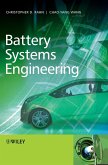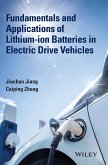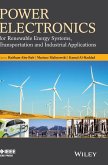Jean-Claude Sabonnadière
Low Emission Power Generation Technologies and Energy Management
Herausgeber: Sabonnadière, Jean-Claude
Jean-Claude Sabonnadière
Low Emission Power Generation Technologies and Energy Management
Herausgeber: Sabonnadière, Jean-Claude
- Gebundenes Buch
- Merkliste
- Auf die Merkliste
- Bewerten Bewerten
- Teilen
- Produkt teilen
- Produkterinnerung
- Produkterinnerung
This title is dedicated to energy storage, low emission technologies and energy management, with discussions on the future of nuclear energy, combined heat and power, using hydrogen as an energy vector and fuel cells, as well as chapters on energy saving and control of the demand for power
Andere Kunden interessierten sich auch für
![Battery Systems Engineering Battery Systems Engineering]() Christopher D. RahnBattery Systems Engineering154,99 €
Christopher D. RahnBattery Systems Engineering154,99 €![Vehicle Safety Communications Vehicle Safety Communications]() Tao ZhangVehicle Safety Communications146,99 €
Tao ZhangVehicle Safety Communications146,99 €![Fundamentals and Applications of Lithium-Ion Batteries in Electric Drive Vehicles Fundamentals and Applications of Lithium-Ion Batteries in Electric Drive Vehicles]() Jiuchun JiangFundamentals and Applications of Lithium-Ion Batteries in Electric Drive Vehicles167,99 €
Jiuchun JiangFundamentals and Applications of Lithium-Ion Batteries in Electric Drive Vehicles167,99 €![Pid and Predictive Control of Electrical Drives and Power Converters Using MATLAB / Simulink Pid and Predictive Control of Electrical Drives and Power Converters Using MATLAB / Simulink]() Liuping WangPid and Predictive Control of Electrical Drives and Power Converters Using MATLAB / Simulink191,99 €
Liuping WangPid and Predictive Control of Electrical Drives and Power Converters Using MATLAB / Simulink191,99 €![Power Electronics for Renewable Energy Systems, Transportation and Industrial Applications Power Electronics for Renewable Energy Systems, Transportation and Industrial Applications]() Haitham Abu-RubPower Electronics for Renewable Energy Systems, Transportation and Industrial Applications205,99 €
Haitham Abu-RubPower Electronics for Renewable Energy Systems, Transportation and Industrial Applications205,99 €![Practical Power Plant Engineering Practical Power Plant Engineering]() Zark BedalovPractical Power Plant Engineering141,99 €
Zark BedalovPractical Power Plant Engineering141,99 €![Origin of Power Converters Origin of Power Converters]() Tsai-Fu WuOrigin of Power Converters156,99 €
Tsai-Fu WuOrigin of Power Converters156,99 €-
-
-
This title is dedicated to energy storage, low emission technologies and energy management, with discussions on the future of nuclear energy, combined heat and power, using hydrogen as an energy vector and fuel cells, as well as chapters on energy saving and control of the demand for power
Hinweis: Dieser Artikel kann nur an eine deutsche Lieferadresse ausgeliefert werden.
Hinweis: Dieser Artikel kann nur an eine deutsche Lieferadresse ausgeliefert werden.
Produktdetails
- Produktdetails
- Verlag: Wiley & Sons
- 1. Auflage
- Seitenzahl: 480
- Erscheinungstermin: 1. August 2009
- Englisch
- Abmessung: 234mm x 163mm x 30mm
- Gewicht: 824g
- ISBN-13: 9781848211360
- ISBN-10: 1848211368
- Artikelnr.: 27429464
- Herstellerkennzeichnung
- Libri GmbH
- Europaallee 1
- 36244 Bad Hersfeld
- 06621 890
- Verlag: Wiley & Sons
- 1. Auflage
- Seitenzahl: 480
- Erscheinungstermin: 1. August 2009
- Englisch
- Abmessung: 234mm x 163mm x 30mm
- Gewicht: 824g
- ISBN-13: 9781848211360
- ISBN-10: 1848211368
- Artikelnr.: 27429464
- Herstellerkennzeichnung
- Libri GmbH
- Europaallee 1
- 36244 Bad Hersfeld
- 06621 890
Jean-Claude Sabonnadière: INPG, Grenoble, France.
Preface xiii
Chapter 1. Energy Storage: Applications to the Electricity Vector 1
Yves BRUNET
1.1. Energy density 1
1.2. Storage problem 4
1.3. Types of storage 14
1.4. Bibliography 48
Chapter 2. Nuclear Fission, Today and Tomorrow: from "Renaissance" to
Technological Breakthroughs 51
Georges VAN GOETHEM
2.1. Introduction: all energy options kept open in 2006 Green Book 52
2.2. Nuclear energy: 50 years of industrial experience 54
2.3. Main actors: common needs, international vision and strategic
instruments 61
2.4. On the eve of a technological breakthrough: six challenges for
research and development 64
2.5. Generation II: supply security and environmental protection 69
2.6. Generation III: continuous improvements in safety and competitiveness
71
2.7. Generation IV (2030 forecast): technological breakthroughs in
competitiveness and sustainability 76
2.8. Education and training: main objectives (modules, mutual recognition,
and mobility) 94
2.9. Conclusion: nuclear energy - a part of the solution in a sustainable
energy mix 95
2.10. Bibliography 97
20.11. List of acronyms 98
Chapter 3. Co-generation 101
William D'HAESELEER and Patrick LUICKX
3.1. Co-generation 101
3.2. Overview of existing technologies 106
3.3. Co-generation installation dimensioning 112
3.4. Assessment of the energy advantage of co-generation 115
3.5. Energy advantage allocation 124
3.6. The electrical aspects of co-generation installations 128
3.7. Cooling by absorption and tri-generation 132
3.8. Estimation of the potential of co-generation 133
3.9. Influence of co-generation on the environment 135
3.10. Conclusions and perspectives 136
3.11. Bibliography 137
Chapter 4. Hydrogen: An Energy Vector 139
Thierry ALLEAU
4.1. Context 139
4.2. Hydrogen: an energy vector for the future? 141
4.3. How do we produce hydrogen? 143
4.4. Hydrogen transportation 151
4.5. Distribution 153
4.6. Hydrogen storage 155
4.7. Applications of hydrogen as energy vector 160
4.8. Risks, standards, regulations and acceptability 166
4.9. A hydrogen economy 169
4.10. The hydrogen players 172
4.11. Conclusions and perspectives 175
4.12. Bibliography 176
Chapter 5. Fuel Cells 179
Pierre BAURENS, Pierre SERRE-COMBE, Jean-Philipe POIROT-CROUVEZIER
5.1. Introduction 179
5.2. Operation principles in different cell types 180
5.3. The system aspect 218
5.4. Energy conversion efficiency 234
5.5. Main applications 240
5.6. Bibliography 260
Chapter 6. Toward Energy Positive Buildings 263
Daniel QUENARD
6.1. Introduction 263
6.2. Energy and buildings: some key figures in Europe 264
6.3. How to move from buildings "addicted to fossil energy" toward"low
energy buildings" (LEB) and, further, toward buildings as power plants
(BaPP) 270
6.4. The Minergie trademark 300
6.5. The PassivHaus label (passive house) 306
6.6. The zero-energy houses: zero-energy house - zero-energy home (ZEH) -
zero-energy buildings (ZEB) 313
6.7. The energy-positive house 319
6.8. Comparison of the three types of houses: Minergie, PassivHaus and ZEH
320
6.9. Beyond the positive-energy building 326
6.10. Bibliography 329
Chapter 7. Light Sources and Lighting: from Technology to Energy Savings
333
Georges ZISSIS
7.1. Lighting in the past and today 333
7.2. Light sources and energy conversion 340
7.3. Energy savings in the lighting field: some typical case studies 365
7.4. What is the future for light sources? 371
7.5. Bibliography 373
Chapter 8. Distributed Generation: Impact and Solutions 375
Raphaël CAIRE and Bertrand RAISON
8.1. Introduction: a threat or an opportunity? 375
8.2. Deregulation 376
8.3. New generation equipment 377
8.4. Impact of distributed generation on electric networks 391
8.5. Solution elements 396
8.6. Conclusion: a challenge and a development opportunity for the
electricity sector 400
8.7. Bibliography 401
Chapter 9. Control of the Energy Demand: Network Load Shedding 405
Guillaume VERNEAU
9.1. Nomenclature 405
9.2. Introduction 406
9.3. Stakes of the load control 407
9.4. Choice of loads to control 412
9.5. Needs in communications, measurements and monitoring to control the
loads 419
9.6. Model and algorithm needs for load control 428
9.7. Conclusion 439
9.8. Bibliography 439
List of authors 442
Index 445
Chapter 1. Energy Storage: Applications to the Electricity Vector 1
Yves BRUNET
1.1. Energy density 1
1.2. Storage problem 4
1.3. Types of storage 14
1.4. Bibliography 48
Chapter 2. Nuclear Fission, Today and Tomorrow: from "Renaissance" to
Technological Breakthroughs 51
Georges VAN GOETHEM
2.1. Introduction: all energy options kept open in 2006 Green Book 52
2.2. Nuclear energy: 50 years of industrial experience 54
2.3. Main actors: common needs, international vision and strategic
instruments 61
2.4. On the eve of a technological breakthrough: six challenges for
research and development 64
2.5. Generation II: supply security and environmental protection 69
2.6. Generation III: continuous improvements in safety and competitiveness
71
2.7. Generation IV (2030 forecast): technological breakthroughs in
competitiveness and sustainability 76
2.8. Education and training: main objectives (modules, mutual recognition,
and mobility) 94
2.9. Conclusion: nuclear energy - a part of the solution in a sustainable
energy mix 95
2.10. Bibliography 97
20.11. List of acronyms 98
Chapter 3. Co-generation 101
William D'HAESELEER and Patrick LUICKX
3.1. Co-generation 101
3.2. Overview of existing technologies 106
3.3. Co-generation installation dimensioning 112
3.4. Assessment of the energy advantage of co-generation 115
3.5. Energy advantage allocation 124
3.6. The electrical aspects of co-generation installations 128
3.7. Cooling by absorption and tri-generation 132
3.8. Estimation of the potential of co-generation 133
3.9. Influence of co-generation on the environment 135
3.10. Conclusions and perspectives 136
3.11. Bibliography 137
Chapter 4. Hydrogen: An Energy Vector 139
Thierry ALLEAU
4.1. Context 139
4.2. Hydrogen: an energy vector for the future? 141
4.3. How do we produce hydrogen? 143
4.4. Hydrogen transportation 151
4.5. Distribution 153
4.6. Hydrogen storage 155
4.7. Applications of hydrogen as energy vector 160
4.8. Risks, standards, regulations and acceptability 166
4.9. A hydrogen economy 169
4.10. The hydrogen players 172
4.11. Conclusions and perspectives 175
4.12. Bibliography 176
Chapter 5. Fuel Cells 179
Pierre BAURENS, Pierre SERRE-COMBE, Jean-Philipe POIROT-CROUVEZIER
5.1. Introduction 179
5.2. Operation principles in different cell types 180
5.3. The system aspect 218
5.4. Energy conversion efficiency 234
5.5. Main applications 240
5.6. Bibliography 260
Chapter 6. Toward Energy Positive Buildings 263
Daniel QUENARD
6.1. Introduction 263
6.2. Energy and buildings: some key figures in Europe 264
6.3. How to move from buildings "addicted to fossil energy" toward"low
energy buildings" (LEB) and, further, toward buildings as power plants
(BaPP) 270
6.4. The Minergie trademark 300
6.5. The PassivHaus label (passive house) 306
6.6. The zero-energy houses: zero-energy house - zero-energy home (ZEH) -
zero-energy buildings (ZEB) 313
6.7. The energy-positive house 319
6.8. Comparison of the three types of houses: Minergie, PassivHaus and ZEH
320
6.9. Beyond the positive-energy building 326
6.10. Bibliography 329
Chapter 7. Light Sources and Lighting: from Technology to Energy Savings
333
Georges ZISSIS
7.1. Lighting in the past and today 333
7.2. Light sources and energy conversion 340
7.3. Energy savings in the lighting field: some typical case studies 365
7.4. What is the future for light sources? 371
7.5. Bibliography 373
Chapter 8. Distributed Generation: Impact and Solutions 375
Raphaël CAIRE and Bertrand RAISON
8.1. Introduction: a threat or an opportunity? 375
8.2. Deregulation 376
8.3. New generation equipment 377
8.4. Impact of distributed generation on electric networks 391
8.5. Solution elements 396
8.6. Conclusion: a challenge and a development opportunity for the
electricity sector 400
8.7. Bibliography 401
Chapter 9. Control of the Energy Demand: Network Load Shedding 405
Guillaume VERNEAU
9.1. Nomenclature 405
9.2. Introduction 406
9.3. Stakes of the load control 407
9.4. Choice of loads to control 412
9.5. Needs in communications, measurements and monitoring to control the
loads 419
9.6. Model and algorithm needs for load control 428
9.7. Conclusion 439
9.8. Bibliography 439
List of authors 442
Index 445
Preface xiii
Chapter 1. Energy Storage: Applications to the Electricity Vector 1
Yves BRUNET
1.1. Energy density 1
1.2. Storage problem 4
1.3. Types of storage 14
1.4. Bibliography 48
Chapter 2. Nuclear Fission, Today and Tomorrow: from "Renaissance" to
Technological Breakthroughs 51
Georges VAN GOETHEM
2.1. Introduction: all energy options kept open in 2006 Green Book 52
2.2. Nuclear energy: 50 years of industrial experience 54
2.3. Main actors: common needs, international vision and strategic
instruments 61
2.4. On the eve of a technological breakthrough: six challenges for
research and development 64
2.5. Generation II: supply security and environmental protection 69
2.6. Generation III: continuous improvements in safety and competitiveness
71
2.7. Generation IV (2030 forecast): technological breakthroughs in
competitiveness and sustainability 76
2.8. Education and training: main objectives (modules, mutual recognition,
and mobility) 94
2.9. Conclusion: nuclear energy - a part of the solution in a sustainable
energy mix 95
2.10. Bibliography 97
20.11. List of acronyms 98
Chapter 3. Co-generation 101
William D'HAESELEER and Patrick LUICKX
3.1. Co-generation 101
3.2. Overview of existing technologies 106
3.3. Co-generation installation dimensioning 112
3.4. Assessment of the energy advantage of co-generation 115
3.5. Energy advantage allocation 124
3.6. The electrical aspects of co-generation installations 128
3.7. Cooling by absorption and tri-generation 132
3.8. Estimation of the potential of co-generation 133
3.9. Influence of co-generation on the environment 135
3.10. Conclusions and perspectives 136
3.11. Bibliography 137
Chapter 4. Hydrogen: An Energy Vector 139
Thierry ALLEAU
4.1. Context 139
4.2. Hydrogen: an energy vector for the future? 141
4.3. How do we produce hydrogen? 143
4.4. Hydrogen transportation 151
4.5. Distribution 153
4.6. Hydrogen storage 155
4.7. Applications of hydrogen as energy vector 160
4.8. Risks, standards, regulations and acceptability 166
4.9. A hydrogen economy 169
4.10. The hydrogen players 172
4.11. Conclusions and perspectives 175
4.12. Bibliography 176
Chapter 5. Fuel Cells 179
Pierre BAURENS, Pierre SERRE-COMBE, Jean-Philipe POIROT-CROUVEZIER
5.1. Introduction 179
5.2. Operation principles in different cell types 180
5.3. The system aspect 218
5.4. Energy conversion efficiency 234
5.5. Main applications 240
5.6. Bibliography 260
Chapter 6. Toward Energy Positive Buildings 263
Daniel QUENARD
6.1. Introduction 263
6.2. Energy and buildings: some key figures in Europe 264
6.3. How to move from buildings "addicted to fossil energy" toward"low
energy buildings" (LEB) and, further, toward buildings as power plants
(BaPP) 270
6.4. The Minergie trademark 300
6.5. The PassivHaus label (passive house) 306
6.6. The zero-energy houses: zero-energy house - zero-energy home (ZEH) -
zero-energy buildings (ZEB) 313
6.7. The energy-positive house 319
6.8. Comparison of the three types of houses: Minergie, PassivHaus and ZEH
320
6.9. Beyond the positive-energy building 326
6.10. Bibliography 329
Chapter 7. Light Sources and Lighting: from Technology to Energy Savings
333
Georges ZISSIS
7.1. Lighting in the past and today 333
7.2. Light sources and energy conversion 340
7.3. Energy savings in the lighting field: some typical case studies 365
7.4. What is the future for light sources? 371
7.5. Bibliography 373
Chapter 8. Distributed Generation: Impact and Solutions 375
Raphaël CAIRE and Bertrand RAISON
8.1. Introduction: a threat or an opportunity? 375
8.2. Deregulation 376
8.3. New generation equipment 377
8.4. Impact of distributed generation on electric networks 391
8.5. Solution elements 396
8.6. Conclusion: a challenge and a development opportunity for the
electricity sector 400
8.7. Bibliography 401
Chapter 9. Control of the Energy Demand: Network Load Shedding 405
Guillaume VERNEAU
9.1. Nomenclature 405
9.2. Introduction 406
9.3. Stakes of the load control 407
9.4. Choice of loads to control 412
9.5. Needs in communications, measurements and monitoring to control the
loads 419
9.6. Model and algorithm needs for load control 428
9.7. Conclusion 439
9.8. Bibliography 439
List of authors 442
Index 445
Chapter 1. Energy Storage: Applications to the Electricity Vector 1
Yves BRUNET
1.1. Energy density 1
1.2. Storage problem 4
1.3. Types of storage 14
1.4. Bibliography 48
Chapter 2. Nuclear Fission, Today and Tomorrow: from "Renaissance" to
Technological Breakthroughs 51
Georges VAN GOETHEM
2.1. Introduction: all energy options kept open in 2006 Green Book 52
2.2. Nuclear energy: 50 years of industrial experience 54
2.3. Main actors: common needs, international vision and strategic
instruments 61
2.4. On the eve of a technological breakthrough: six challenges for
research and development 64
2.5. Generation II: supply security and environmental protection 69
2.6. Generation III: continuous improvements in safety and competitiveness
71
2.7. Generation IV (2030 forecast): technological breakthroughs in
competitiveness and sustainability 76
2.8. Education and training: main objectives (modules, mutual recognition,
and mobility) 94
2.9. Conclusion: nuclear energy - a part of the solution in a sustainable
energy mix 95
2.10. Bibliography 97
20.11. List of acronyms 98
Chapter 3. Co-generation 101
William D'HAESELEER and Patrick LUICKX
3.1. Co-generation 101
3.2. Overview of existing technologies 106
3.3. Co-generation installation dimensioning 112
3.4. Assessment of the energy advantage of co-generation 115
3.5. Energy advantage allocation 124
3.6. The electrical aspects of co-generation installations 128
3.7. Cooling by absorption and tri-generation 132
3.8. Estimation of the potential of co-generation 133
3.9. Influence of co-generation on the environment 135
3.10. Conclusions and perspectives 136
3.11. Bibliography 137
Chapter 4. Hydrogen: An Energy Vector 139
Thierry ALLEAU
4.1. Context 139
4.2. Hydrogen: an energy vector for the future? 141
4.3. How do we produce hydrogen? 143
4.4. Hydrogen transportation 151
4.5. Distribution 153
4.6. Hydrogen storage 155
4.7. Applications of hydrogen as energy vector 160
4.8. Risks, standards, regulations and acceptability 166
4.9. A hydrogen economy 169
4.10. The hydrogen players 172
4.11. Conclusions and perspectives 175
4.12. Bibliography 176
Chapter 5. Fuel Cells 179
Pierre BAURENS, Pierre SERRE-COMBE, Jean-Philipe POIROT-CROUVEZIER
5.1. Introduction 179
5.2. Operation principles in different cell types 180
5.3. The system aspect 218
5.4. Energy conversion efficiency 234
5.5. Main applications 240
5.6. Bibliography 260
Chapter 6. Toward Energy Positive Buildings 263
Daniel QUENARD
6.1. Introduction 263
6.2. Energy and buildings: some key figures in Europe 264
6.3. How to move from buildings "addicted to fossil energy" toward"low
energy buildings" (LEB) and, further, toward buildings as power plants
(BaPP) 270
6.4. The Minergie trademark 300
6.5. The PassivHaus label (passive house) 306
6.6. The zero-energy houses: zero-energy house - zero-energy home (ZEH) -
zero-energy buildings (ZEB) 313
6.7. The energy-positive house 319
6.8. Comparison of the three types of houses: Minergie, PassivHaus and ZEH
320
6.9. Beyond the positive-energy building 326
6.10. Bibliography 329
Chapter 7. Light Sources and Lighting: from Technology to Energy Savings
333
Georges ZISSIS
7.1. Lighting in the past and today 333
7.2. Light sources and energy conversion 340
7.3. Energy savings in the lighting field: some typical case studies 365
7.4. What is the future for light sources? 371
7.5. Bibliography 373
Chapter 8. Distributed Generation: Impact and Solutions 375
Raphaël CAIRE and Bertrand RAISON
8.1. Introduction: a threat or an opportunity? 375
8.2. Deregulation 376
8.3. New generation equipment 377
8.4. Impact of distributed generation on electric networks 391
8.5. Solution elements 396
8.6. Conclusion: a challenge and a development opportunity for the
electricity sector 400
8.7. Bibliography 401
Chapter 9. Control of the Energy Demand: Network Load Shedding 405
Guillaume VERNEAU
9.1. Nomenclature 405
9.2. Introduction 406
9.3. Stakes of the load control 407
9.4. Choice of loads to control 412
9.5. Needs in communications, measurements and monitoring to control the
loads 419
9.6. Model and algorithm needs for load control 428
9.7. Conclusion 439
9.8. Bibliography 439
List of authors 442
Index 445








